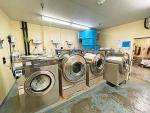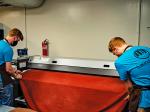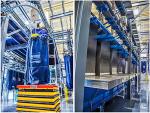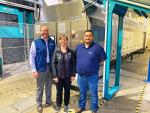Commercial Laundry: Lee Baldauf, Superior Linen Service, Tacoma, Wash.
Lee Baldauf
Automation is something every plant in America has … sort of.
Literally, we went from stones in a river to washboards to washers and extractors to washer-extractors and tunnels with presses.
Making the next step is always a little painful. So many challenges beyond the financial burdens. Plant space, utilities and training are all parts of the equation.
From an engineer’s standpoint, a new plant auto weighs slings at the count/sort, leaving automatically to a tunnel to shuttles to feeding equipment and packaging … Well, that is the eventuality.
Labor trends and inflation will eventually force us there or to our respective finish dates.
I encourage everyone, especially those with the “what can I do now-ish” question, to attend Clean this year to see what is out there. This is a great venue to establish new networks with great vendors who really do want you to be successful. Their business depends on it.
Invite these salespeople to your plant. You might give an hour or two to one of these folks, and their experience and wisdom might have you asking how you missed such low-hanging fruit.
I have experienced, almost always, these folks to be honest and truly wanting to offer you a better way with a quick return on investment (ROI).
As for most affordable options for improving your operation, that depends on the plant, but some really easy choices are the ones that eliminate production hours. Maybe production planning systems (PPS) that keep employees on track with simple screens and lights.
If you are hand folding, stop! Think bagger and/or small-piece folders. Have two people folding robes? Get a robe folder and reduce that to one person. Wrapping at wrap stations? If you need to staff more than a few of them, go autowrap.
I would love to go through the two- or three-year process of pain, building a fully automated plant, just so I could see the benefits of doing twice the poundage with half the people, but that would require large amounts of capital, time, stress and heartache.
I have seen many pieces of automation implemented at our conventional plant. Some have been better than others, but all have helped the process.
An important side note to all of this is you are not killing jobs. Any improvements we benefited from were handled easily through attrition. I mean, what is your revolving door number for employees currently? That will be the key driver in your search for affordable improvements.
It is simply too challenging to find great people for production today, and labor is becoming increasingly expensive.
I will be at Clean looking at specific items, but I also hope to see something that I didn’t even know existed. Evolve, or die.
Chemicals Supply: John Schafer, Diversey, Fort Mill, S.C.
John Schafer
Most, if not all, automated processes in a commercial laundry require an investment in equipment.
All you can do is evaluate your processing procedures from gathering to sorting to washing to finishing to look for ways to streamline the processes.
Without equipment to do this, people will, and you can look to see if there are areas that can be improved.
Consulting Services: Jon Witschy, Spindle, Woodridge, Ill.
Jon Witschy
Start somewhere. Labor is obviously one of the major costs within a laundry operation, and it is increasing, so automation can have quite an impact.
Although a large project might obviously remove personnel from an operation, streamlining any activity should have a payback.
Heck, one of the advantages that we have identified with our software offerings is simply the automatic collection of data. Our solutions don’t handle, process or transport any laundry items, but they eliminate the need for personnel to manually collect and enter details from the plant floor, thus saving a significant amount of time.
Plenty of systems could have this same impact, which you might not have considered.
You should also evaluate options in how you implement a project. If leasing or financing is feasible, you might actually be in a good position to go for those “major equipment purchases” referenced in the question.
Leasing/financing can generate cash flow since you pay for a project with the money that you are saving on labor. Here’s an example, using round numbers.
Let’s say a project costs $120,000 and would save $120,000 per year in labor, or $10,000/month. If you paid upfront, you’d recoup those funds for a payback period of one year; however, if you leased it for three years at $3,750/month, you’d pay for it with your labor savings and have an extra $6,250 each month.
With all of the above stated, you should look for the bottlenecks and waste in your plant. Automation for any of these areas could help.
Where are employees waiting on product? Where is product backing up? A change to your process flow and/or a small investment in material handling, storage, etc., should deliver for you.
Rather than an entire “system,” are there options for automating part of an operation?
Install a feeder on one machine, versus all of them. Install automated soil sorting of your highest-volume items with manual handling of the rest. Add labeling and automatic scanning for your highest-dollar products with manual or bulk tracking for the rest.
For equipment that experiences too much downtime (which also wastes labor and has an impact on throughput), consider a major part replacement or machine overhaul, rather than a whole new machine.
Good luck as we all work to improve our operating costs!
Check back tomorrow for insights from hotel/motel/resort laundry and equipment manufacturing experts.
Have a question or comment? E-mail our editor Matt Poe at [email protected].



























































